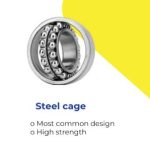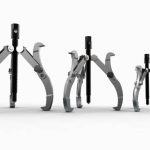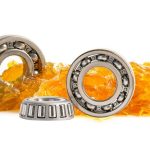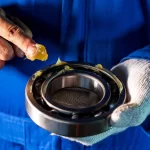A bearing heater is a device that is used to heat the bearings before mounting and dismounting them. ‘There is no one size fits all’ approach when it comes to bearings thus necessitating the need for bearing heaters that allow the mounting of bearings by heating them to slide onto the shaft with minimal force without damaging them.
Optimal performance, longevity, and durability of bearings are influenced by the proper installation. Bearing heaters play a crucial role in avoiding misalignment while installing bearings by heating the inner ring of the bearing causing it to thermally expand allowing for easy mounting. Bearing heaters are commonly used for small to medium-sized bearings like roller bearings, ball bearings, sphering roller bearings, cylindrical roller bearings, tapered roller bearings, and more.
Controlled Heating in Bearing Installation - How it Reduces Damage & Improves Efficiency?
Bearing heaters are equipped with temperature sensors to measure the temperature as the bearing heats. Additionally, some heaters are also equipped with adjustable thermostats to prevent the bearings from overheating. Controlled heating is improved for the following reasons:
- Prevents from Overheating & Damage: Overheating of a bearing can alter its metallurgy and significantly impact the bearing’s hardness and lifespan. The key is to keep the temperature within the manufacturer’s recommended range.
- Avoids Shaft Damage & Reduce Installation Force: Using bearing heaters with controlled heating for installation avoids the need for cold mounting, which involves applying force to fit the bearing in place, usually causing damage to the shaft and bearing race.
- Ensure Even Expansion: For even bearing expansion, bearing heaters are widely preferred over ovens or open flames. Bearing heaters are known for consistent uniform heating, evenly expanding the bearings, and preventing distortions.
- Quicker & Safer Installation: Controlled heating cuts down on mounting time and minimises the possibility of worker injury and shaft damage during installation. Several heaters automatically control temperature and alert when the bearing is ready for installation leading to avoiding overheating and damage.
- Maintains Lubricant Integrity: Controlled heating avoids uneven heating that can burn off lubricants, affecting lubrication and increasing friction. It ensures that pre-greased bearings retain their lubricant properties.
Why use a Bearing Heater?
Bearing heaters are used to expand a bearing to mount or dismount them without using excessive force or cold mounting/dismounting them. Bearing heaters are commonly used for:
- Mounting: To mount bearings onto shafts, gears, and other machine components
- Dismounting: To remove bearings from shafts, gears, and other machine components.
- Heating other Components: Also used for heating gears, pulleys, bushing, etc.
Advantages of Using a Bearing Heater:
- Controlled Heating: The most significant advantage of using a bearing heater is that it allows for precise temperature control. The bearing heater maintains a safe temperature to prevent metallurgical damage and ensure the bearing is heated at the right temperature needed for installation.
- Reduced Bearing Damage: Using a bearing heater eliminates the need for the use of mechanical force – hammering or pressing, thus avoiding the risk of brinelling, cracks, or misalignment during installation.
- Faster & Efficient Installation: Bearing heaters heat the bearings quickly, allowing for quicker installation, reduced machinery downtime, and eliminating the need for excessive manual force, reducing worker fatigue.
- Safer Operation: Bearing heaters are considered safer options for heating bearings compared to traditional heating methods like torches with open flames. Bearing heaters eliminate fire hazards with torches and are also built with built-in sensors to prevent overheating.
- Extends Bearing Life & Performance: Controlled heating helps avoid microcracks or deformities that could lead to premature failure. Additionally, controlled heating ensures that pre-greased bearings retain their lubricant.
Types of Bearing Heaters?
There are various types of bearing heaters available based on the heating method, efficiency, and application size. Some of the most common types of bearing heater are:
- Induction Bearing Heater: These bearing heaters use electromagnetic induction to heat the bearing. Induction-bearing heaters are the most widely used heaters and are designed with a yoke that is placed through the bearing bore.
- Hot Plate Bearing Heater: Hot plate bearing heaters use conduction-based heating, the bearing is placed on a heated metal plate. Hot plate heaters are usually preferred for smaller bearings.
- Cone-style Bearing Heaters: Cone-style heaters as the name implies are cone-shaped and are designed to accommodate bearings of different sizes. The heat in such heaters is transferred through the cone to the bearing’s inner ring.
How to Choose the Right Bearing Heater?
The saying ‘different situations call for different approaches’ holds true when it comes to choosing the right bearing heater. Several factors play a key role when deciding upon the right bearing heater for your needs, some of them are listed below:
- Bearing Size & Type: Bearing heaters must be chosen based on the size of the bearing. Usually for smaller bearings like small deep groove ball bearings hot plate bearings are used, while for a large spherical roller bearing induction bearing heater is usually recommended.
- Heating Method: Heaters must be selected based on the heating requirements, induction heaters are used for quick heating while hot plate heaters gradually heat the bearing. In high-production environments requiring quick mounting induction heaters are preferred while hot plate bearings are useful for controlled heating.
- Application Environment: The application environment plays a key role in deciding upon the right bearing heater. Portable induction heaters are best for on-site maintenance while fixed heaters are best suited for workshops.
- Energy Efficiency: Choosing the bearing heater based on energy consumption is also a key factor affecting choosing the right bearing. Induction heaters usually consume less power compared to hot plate heaters.
Applications of Bearing Heaters in Different Industries
| Industry | Application |
| Automobiles | Mounting bearings in engines, wheel hubs, etc. |
| Power Generation | Installing bearings in turbines, generators, and more. |
| Aerospace | Fitting bearings in landing gears, shafts, and engines. |
| Railways | Fitting large bearings in locomotives and rolling stock. |
| Manufacturing | Mounting bearings on machine tools, conveyor belts, etc. |
Accessories for Bearing Heaters
- Heat Protective Gloves: Handling the bearings both before and after they have been heated requires the use of gloves. Heat-protective gloves are designed to prevent burns and also protect the bearings from scratches.
- Bearing Puller: Bearing puller is used to remove bearings from shafts, housings, and other mechanical parts. The puller ensures that the parts and components are taken out without getting damaged. The bearing puller is designed to operate in confined spaces and allows technicians to extract the bearings, gears, pulleys, etc. while avoiding damage to surrounding parts and reducing machine downtime.
- Temperature Monitoring Tool: Various types of thermometers like infrared thermometers are used to measure the bearing temperature to prevent overheating. Advanced bearing heaters are equipped with digital thermometers and displays.
- Supportive Accessories: Accessories like spacer rings, supportive blocks, alignment tools, centring devices, and others are commonly used to ensure proper heating, and installation, and reduce downtime.
FAQ's
What is a bearing heater used for?
A bearing heater is a device that is used to heat the bearings before mounting and dismounting them.
What is the best way to heat a bearing?
The best way to heat a bearing is through the use of a bearing heater. Bearing heaters are used for their temperature control, suitability for various sizes, and safer operations.
What are the names of bearing heaters?
A general guideline is to heat them to a temperature of 80-90°C. However, bearings must be heated as per the manufacturer’s guidelines.
Why do you heat bearings?
Bearings are heated to expand them to mount or dismount them without using excessive force or cold mounting/dismounting them.



















